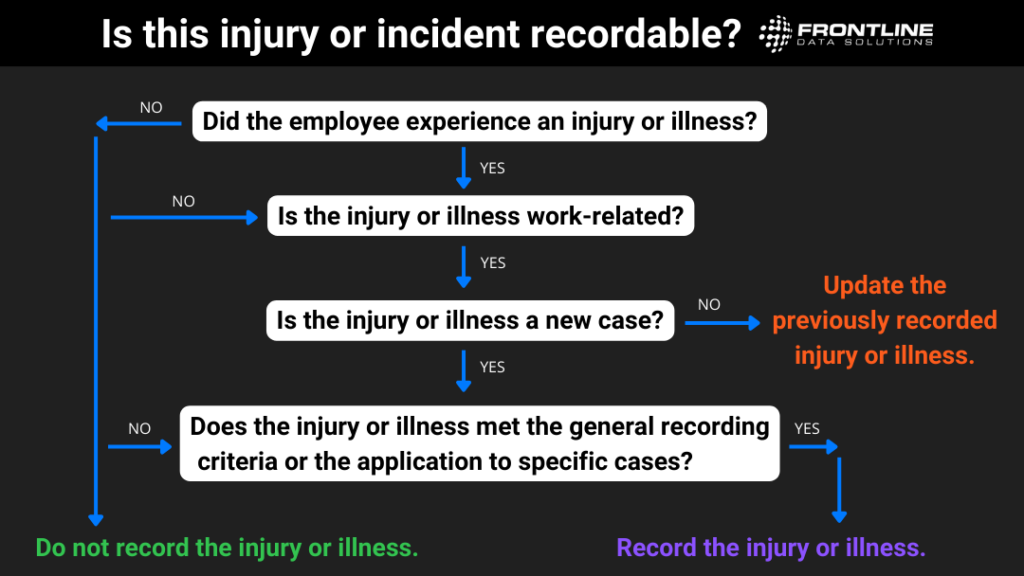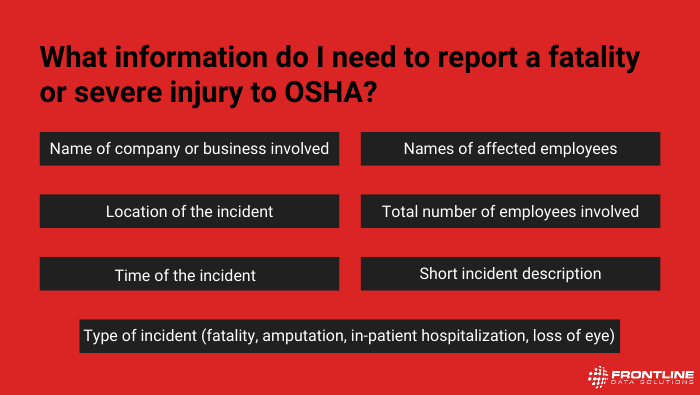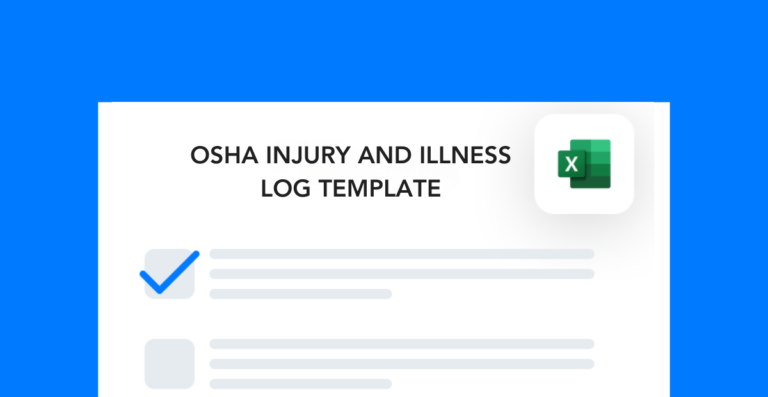A complete guide to OSHA’s reporting requirements
It can be difficult to keep up with all the relevant OSHA reporting requirements for your site. Maybe your operation falls under multiple industries. Or maybe you’re growing quickly and struggling to keep up with compliance.
Unfortunately, you can’t really afford to risk noncompliance. And this goes beyond simply knowing what OSHA requires from you. For lasting success, you need a dedicated approach for tracking the reporting process from start to finish.
Reporting different types of incidents
OSHA’s reporting requirements vary depending on the severity of an event. You can categorize incidents into two main categories: minor and severe. Before you report anything, you first need to categorize the incident.
Use this handy diagram to decide whether you’re dealing with an OSHA-recordable incident:

Overall, the process for reporting incidents is not too complicated. If you’re missing key details, however, you might have some trouble getting your reports done. Make sure you have all the required information first. That way you won’t have to backtrack and restart the reporting process.
Severe injuries and fatalities
There are very specific requirements for reporting fatalities and severe injuries. OSHA requires businesses to report any fatalities within 8 hours of when they occur.
There are three main types of severe injuries that have to be reported as well. They include:
- Amputation
- Loss of eye
- Inpatient hospitalization
These injuries must be reported within 24 hours of when they occur, not 8. Although these types of injuries are less severe than fatalities, it’s equally important to report them on time.
You should note that these requirements extend to all OSHA regulated businesses regardless of size or industry. So even if you have less than 10 employees, you’re required to report fatal and severe injuries.
Anyone working within your EHS department should be very aware of these requirements. You want to make sure that junior staff can handle critical situations, even if leaders are away.
There are three main places to report a fatality or severe injury:
- Online form
- OSHA 24-hour hotline
- Local OSHA office
If you try your local office and they don’t answer, you still have to get through to another reporting option. In that case, try the online portal or hotline.
The 8-hour and 24-hour timelines won’t extend simply because you can’t get ahold of someone on the phone. This is why it’s so important to report as soon as possible—you don’t want to miss the reporting window.
When you make the report, you’ll need a few key pieces of information. They include:

Sometimes, a severe injury or fatality happens after the initial incident. If there is a gap between the two, you may still have to report it to OSHA.
Any fatalities that take place within 30 days of the incident must be reported. Similarly, amputations, in-patient hospitalizations, and eye losses that happen within 24 hours of the work incident must also be reported.
After you’ve reported this information, you’ll need a way to document incidents. An organized system is the key to ensuring OSHA compliance in the future.
Near misses and minor injuries
The rules for near misses and minor are injuries are different. There is no strict OSHA reporting requirement that says you have to notify anyone right away.
For these types of incidents, you’ll have to keep detailed records. But they fall under the OSHA recordkeeping standard, not the reporting requirements.
Recordkeeping guidelines
The work doesn’t end once you’ve reported an incident. Under OSHA standard 1904 29 CFR, employers have to maintain records for fatalities, illnesses, and injuries that are new, work-related, and applicable to the general recording criteria.
For reference, the general recording criteria for 1904 29 CFR includes injuries or illnesses that lead to at least one of the following results:
- Loss of consciousness
- Death
- Work restrictions or job transfer
- Days away from work
- Significant injury as determined by the health care provider
The only businesses that do not have to follow these guidelines are:
- Businesses that have 10 or fewer employees
- Businesses in low-hazard industries
OSHA has a full list of exempt businesses on its website. Examples of low-hazard industries include academic institutions, dentist offices, and law offices (among many others).
There are three main forms that fall under the recordkeeping standard:
- 300: Work-related injuries, illnesses, and fatalities (reported on a rolling basis)
- 300A: Total number of incidents and their outcomes (reported annually)
- 301: Injury and illness incident reports (reported on a year-round basis)
Under the recordkeeping standard, you have to store these records for five years. If, during that time, the description or result of an incident changes, you need to update it. Your incident logs should accurately reflect the details of the case. This means that you need to be able to find and adjust your reports often. In other words, storage and access are key.
Successful compliance with the recordkeeping standard depends on an organized documentation system. Unfortunately, many companies still make the mistake of filing their important records manually. Nowadays, a digital file keeping system is the preferred solution for businesses who deal regularly with workplace incidents and widespread OSHA compliance.
EHS software for OSHA reporting compliance
Storing incident records in a paper format or within file folders on a computer works for the short term. But it’s not a great approach for long-term growth or success.
Having a scalable system is very important if you plan on expanding your workforce or number of locations. If you keep all your records on a single computer, for example, what happens when you have several sites to oversee?
How will you compile the company’s recordable incident data to send to OSHA? At the very least, you’ll have to collect reports from individuals, teams, or sites. And this is not only a poor use of time, but also an easy way to miss a critical compliance measure.
The best way to handle OSHA reporting requirements is to use a cloud-based storage solution. That’s because it gives you oversight over the entire company’s EHS data. Instead of tracking down incident logs from each site, you can view them all within a single location.
OSHA recordkeeping software allows you to log all incident reports directly in the cloud. With that capability, you’ll be able to view your records at any time. And once the end of the year rolls around, you’ll be able to find the information needed for form 300A.
This level of simplicity is a necessity for large organizations. And it makes growth that much easier for small to midsize companies. As you figure out the system that works best for your site’s OSHA reporting compliance, think about how much time you want to devote to the process. If your current approach keeps your EHS team in the office instead of the field, you should seriously consider switching to a digital system.




